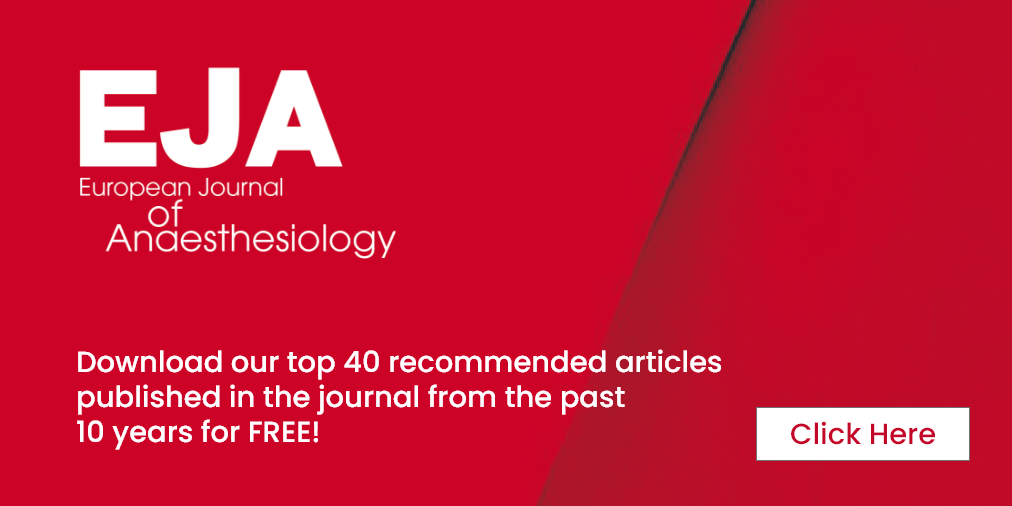Congress Newsletter 2023
40 Years of the European Journal of Anaesthesiology (EJA): Advancing Knowledge and Innovation in Anaesthesiology and Intensive Care
Introduction
With a remarkable history spanning over 40 years, the EJA has been at the forefront of publishing original research, review articles, guidelines, editorials and case reports encompassing all facets of anaesthesiology and intensive care medicine. As a peer-reviewed publication, the journal has served for over 40 years as a vital platform for the dissemination of new knowledge, ideas, and techniques within the field. The EJA has played a vital role in advancing, innovation, and collaboration in the field of anaesthesiology and intensive care. With its broad coverage of diverse topics, including perioperative medicine, pain management, critical care, resuscitation, and patient safety, the journal has served as an indispensable resource for researchers, clinicians, and educators across Europe and beyond. The EJA contributes significantly to improving patient outcomes and driving excellence in anaesthesiology and intensive care practice by fostering the dissemination of ground-breaking research, guidelines, and expert opinions.
Comprehensive Coverage of Anaesthesiology and Intensive Care
Over the years, the EJA has covered a wide range of topics relevant to anaesthesiology and intensive care, catering to the diverse needs of researchers, clinicians, and educators. This broad scope has allowed for a comprehensive understanding of the field and facilitates interdisciplinary collaboration.
During its 40 years of existence in perioperative medicine, the EJA has published articles addressing preoperative risk assessment, intraoperative monitoring techniques, and postoperative care strategies. The journal has also dedicated considerable attention to pain management, including regional anaesthesia techniques, opioid use, and non-pharmacological approaches to pain relief. Furthermore, the EJA has explored crucial topics in critical care, such as mechanical ventilation, sepsis management, organ support, and resuscitation protocols, including advanced cardiac life support and trauma management. Patient safety remains a key focus, encompassing areas like medication errors, infection control, and human factors affecting patient outcomes.
Special Issues and Supplements
In addition to its regular publications, the European Journal of Anaesthesiology offers special issues and supplements on specific themes to provide in-depth coverage of emerging trends and advances in the field. These special editions often delve into specialised areas of anaesthesiology, such as obstetric anaesthesia, paediatric anaesthesia, and perioperative medicine in the elderly or guidelines. The journal provides valuable insights and evidence-based recommendations tailored to distinct patient populations and clinical scenarios by exploring these specific topics.
Guidelines and Consensus Statements
The EJA serves as a platform for publishing guidelines and consensus statements developed by the ESAIC or by other societies. These guidelines represent the collective expertise and recommendations of leading experts in the field, helping to shape clinical practice and establish standards of care. By disseminating these guidelines, the journal ensures that the latest evidence-based practices reach anaesthesiologists and intensivists worldwide, promoting high-quality patient care and safety.
The new EJA Strategy announced in 2022
In 2022, the ESAIC introduced several significant changes and updates to enhance the European Journal of Anaesthesiology (EJA) and the new Open Access journal, the European Journal of Anaesthesiology and Intensive Care (EJAIC). These changes reflect a commitment to continually improve the journals and offer an expanded range of article types to meet the evolving needs of the anaesthesiology and intensive care community. Both EJA and EJAIC now accept new types of articles to diversify the content and provide valuable insights to readers. These include clinical reasoning papers, secondary analysis articles, articles focusing on guidelines’ implementation, and pro-con debate papers. This expansion allows for a broader spectrum of scholarly contributions and encourages in-depth discussions and analysis within the field.
In addition, EJAIC will introduce a “Metrology” series, which aims to explore the measurement and standardisation of anaesthesiology and intensive care practices. This series will delve into the precision and accuracy of measurements, offering valuable insights into the quantitative aspects of the field.
EJA will now welcome protocols for publication, accompanied by the full article published in either journal. This initiative promotes transparency and encourages researchers to share detailed protocols, ensuring a comprehensive understanding of the study design and methodology.
To maintain the integrity of published research, the journals will now request raw data from authors more regularly. This practice aims to verify the authenticity and reliability of the data presented in the articles. Additionally, overlaps and similarities exceeding 20% between submitted manuscripts will be rejected to maintain high standards of originality.
Recognising the valuable contributions of handling editors, the journals have decided to include them in the acknowledgements section of published articles. This acknowledgement highlights their important role in the peer-review process and manuscript handling.
To support the professional growth of peer reviewers, a mentorship scheme will be provided, offering guidance and support to reviewers. This initiative aims to enhance the quality of peer reviews and foster a constructive and collaborative environment.
The journals also encourage the submission of visual abstracts, allowing authors to present their research findings visually engagingly. Visual abstracts provide a concise and visually appealing summary of the study, facilitating a quick understanding of the key findings.
The 40 years of EJA in scientific publications
To celebrate its 40th anniversary, EJA has compiled a list of the top 40 articles published in the past 10 years. These articles cover a diverse range of topics and are available for free download. Some notable articles include evidence-based and consensus-based guidelines on various subjects such as postoperative delirium, procedural sedation and analgesia in adults, pre-operative evaluation for noncardiac surgery, and management of severe perioperative bleeding.
The list also features studies on perioperative medicine, pain management, respiratory complications, ultrasound-guided regional anaesthesia, fasting in children, fluid therapy, chronic postsurgical pain, patient satisfaction, lung cancer surgery, and many more.
The EJA is committed to continue being a platform for the worldwide dissemination of research in the field of anaesthesia and intensive care medicine by focusing on pre-clinical, practical, and clinical aspects of care. The publication output highlights will continue to represent value in high levels of original scientific research and emphasis on recommendations, guidelines, clinical advice, and basic research. As a leading platform for research dissemination in the field, the EJA is committed to continuing to play a crucial role in advancing knowledge and sharing important findings among the global anaesthesiology and intensive care community.
About EJA
The European Journal of Anaesthesiology (EJA) is a prestigious publication and the official journal of the European Society of Anaesthesiology and Intensive Care (ESAIC). With a history spanning over 40 years, the EJA has established itself as a leading source of scientific research and knowledge in the field of anaesthesiology and intensive care medicine. The journal publishes original work of high scientific quality, including clinical studies, laboratory research, experimental studies, and technological advancements. It covers a wide range of topics, such as perioperative medicine, pain management, critical care, resuscitation, patient safety, and more. The EJA is known for its rigorous peer-review process and commitment to providing a platform for the dissemination of new ideas, techniques, and evidence-based guidelines. It serves as an essential resource for researchers, clinicians, and educators in Europe and beyond, contributing to advancements in anaesthesiology and improving patient care.
For more information, please visit the EJA official website
Arta Leci MA
Marketing and Communication Manager
Prof. Marc Samama
Editor-in-Chief (EIC) for the European Journal of Anaesthesiology (EJA),











